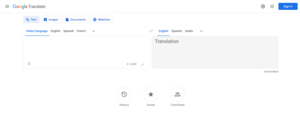Launched by Google[1] in 2006, Google Translate has become a vital translation tool used predominantly for translating text, speech, and visuals. It has evolved from being a statistical to a neural machine translation service over the years, with mobile app versions for Android and iOS released in 2010 and 2011. Google Translate offers a range of translation modes, including website, document, speech transcription, and bilingual conversation. Beyond just translating, it also provides pronunciation guidance, dictionary definitions, and listening capabilities. It’s capable of translating various media types and synthesizing speech from text in certain languages. With the ‘Detect language’ feature, it can recognize unidentified languages. It also welcomes suggestions for alternative translations and corrections. Google Translate’s web interface creates shareable URLs for translations, enhancing its user-friendliness. It takes into account regional accents, providing variations for languages like English, Spanish, Portuguese, French, and Bengali.
Google Translate is a multilingual neural machine translation service developed by Google to translate text, documents and websites from one language into another. It offers a website interface, a mobile app for Android and iOS, as well as an API that helps developers build browser extensions and software applications. As of 2022, Google Translate supports 133 languages at various levels; it claimed over 500 million total users as of April 2016[update], with more than 100 billion words translated daily, after the company stated in May 2013 that it served over 200 million people daily.
 | |
 Google Translate website homepage | |
Type of site | Neural machine translation |
|---|---|
| Available in | 133 languages; see below |
| Owner | |
| URL | translate |
| Commercial | Yes |
| Registration | Optional |
| Users | Over 610 million people daily |
| Launched | April 28, 2006 (as statistical machine translation) November 15, 2016 (as neural machine translation) |
| Current status | Active |
Launched in April 2006 as a statistical machine translation service, it used United Nations and European Parliament documents and transcripts to gather linguistic data. Rather than translating languages directly, it first translates text to English and then pivots to the target language in most of the language combinations it posits in its grid, with a few exceptions including Catalan–Spanish. During a translation, it looks for patterns in millions of documents to help decide which words to choose and how to arrange them in the target language. Its accuracy, which has been criticized on several occasions, has been measured to vary greatly across languages. In November 2016, Google announced that Google Translate would switch to a neural machine translation engine – Google Neural Machine Translation (GNMT) – which translates "whole sentences at a time, rather than just piece by piece. It uses this broader context to help it figure out the most relevant translation, which it then rearranges and adjusts to be more like a human speaking with proper grammar".
